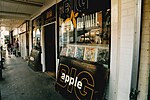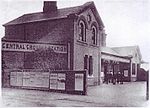Surrey Street Market
History of the London Borough of CroydonRetail markets in LondonShopping in the London Borough of CroydonStreets in the London Borough of CroydonUse British English from November 2017

Surrey Street Market (also known as Croydon Market) is a street market located in Surrey Street, Croydon, south London. Records of a market on the site date back to the 13th century. It operates six days a week, Monday to Saturday, and mainly sells fruit and vegetables.
Excerpt from the Wikipedia article Surrey Street Market (License: CC BY-SA 3.0, Authors, Images).Surrey Street Market
Matthews Yard, London Broad Green (London Borough of Croydon)
Geographical coordinates (GPS) Address Nearby Places Show on map
Geographical coordinates (GPS)
| Latitude | Longitude |
|---|---|
| N 51.372694444444 ° | E -0.10125 ° |
Address
Matthews Yard
CR0 1FF London, Broad Green (London Borough of Croydon)
England, United Kingdom
Open on Google Maps










